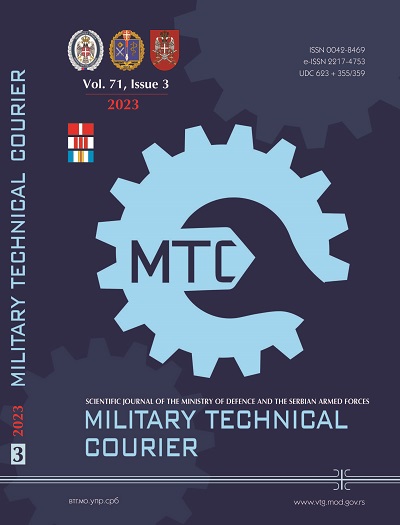Numerical analysis of the penetration process of a 30mm armor-piercing projectile
Abstract
Introduction/purpose: Thin plates made of high–strength steel are frequently used both in civil and military ballistic protection systems. In order to choose an appropriate type of alloy, it is necessary to fulfil a number of criteria, such as the condition of use, the desired ballistic performance, weight, dimensions, and price. This paper presents a numerical analysis of the penetration ofa 30mm armor-piercing projectile with a velocity of 750m/s intosteel alloy Weldox 460plates of different thicknessesat a distance of 1000m .
Methods: The analysis has been performed using numerical methods and finite element modeling to calculate stresses and deformation caused by the penetration effect. For defining material characteristics, the Johnson-Cook material model and the fracture of materials model have been used. In this paper, the software packages FEMAP and LS Dyna have been used for defining models and performing numerical calculations.
Results: The results of the performed numerical analysis as well as the obtained stress and displacement values are presented for four different armor plate thicknesses: 30mm, 33mm, 34mm, and 40mm. The results show a penetration effect and an interaction between the projectile and the armor plate.
Conclusion: Modeling the impact on armor-piercing obstacles is very complex, extensive, and demanding, and the formed models approximate the real problem of projectile penetration in a very successful way (or with a certain deviation). In recent times, the analysis using the finite element method has proven to be one of effective approaches to solving such and similar problems. The material and the dimensions of the obstacle, as well as the material and the ballistic parameters of the projectile have the greatest influence on projectile penetration. Keeping all the input parameters at the same level andincreasing the thickness of the target leads toits increased resistance to penetration.
References
Bataev, I.A., Tanaka, S., Zhou, Q., Lazurenko, D.V., Jorge Junior, A.M., Bataev, A.A., Hokamoto, K., Mori, A. & Chen, P. 2019. Towards better understanding of explosive welding by combination of numerical simulation and experimental study. Materials & Design, 169, art.number:107649. Available at: https://doi.org/10.1016/j.matdes.2019.107649.
Champagne, V.K., Helfritch, D.J., Trexler, M.D. & Gabriel, B.M. 2010. The effect of cold spray impact velocity on deposit hardness. Modelling and Simulation in Materials Science and Engineering, 18, art.number:065011. Available at: https://doi.org/10.1088/0965-0393/18/6/065011.
Elek, P. 2018. Balistika na cilju.Belgrade: University of Belgrade, Faculty of Mechanical Engineering (in Serbian). ISBN: 978-86-7083-966-3 [online]. Available at: https://www.mas.bg.ac.rs/_media/biblioteka/izdanja/17/17.02.pdf [Accessed: 03 March 2023].
Heuzé, O. 2012. General form of the Mie–Grüneisen equation of state. Comptes Rendus Mécanique, 340(10), pp.679-687. Available at: https://doi.org/10.1016/j.crme.2012.10.044.
Liu, Z.S., Swaddiwudhipong, S. & Islam, M.J. 2012. Perforation of steel and aluminum targets using a modified Johnson–Cook material model. Nuclear Engineering and Design, 250, pp.108-115. Available at: https://doi.org/10.1016/j.nucengdes.2012.06.026.
Murthy, V.C.A.D. & Santhanakrishnanan, S. 2020. Isogrid lattice structure for armouring applications. Procedia Manufacturing, 48, pp.e1-e11. Available at: https://doi.org/10.1016/j.promfg.2020.05.099.
Rezasefat, M., Mostofi, T.M., Babaei, H., Ziya-Shamami, M. & Alitavoli, M. 2018. Dynamic plastic response of double-layered circular metallic plates due to localized impulsive loading. Proceedings of the Institution of Mechanical Engineers, Part L: Journal of Materials: Design and Applications, 233(7), pp.1449-1471. Available at: https://doi.org/10.1177/1464420718760640.
Spasić, D.M. 2018. Numerical modeling of the impact of projectiles on metal structures. Vojnotehnički glasnik/Military Technical Courier, 66(1), pp.63-105. Available at: https://doi.org/10.5937/vojtehg66-9604.
Wang, X. & Shi, J. 2013. Validation of Johnson-Cook plasticity and damage model using impact experiment. International Journal of Impact Engineering, 60, pp.67-75. Available at: https://doi.org/10.1016/j.ijimpeng.2013.04.010.
Wilkins, M.L. 1999.Computer Simulation of Dynamic Phenomena. Heidelberg: SpringerBerlin. Available at: https://doi.org/10.1007/978-3-662-03885-7.
Copyright (c) 2023 Predrag R. Pantović, Miroslav M. Živković, Vladimir P. Milovanović, Nenad M. Miloradović

This work is licensed under a Creative Commons Attribution 4.0 International License.
Proposed Creative Commons Copyright Notices
Proposed Policy for Military Technical Courier (Journals That Offer Open Access)
Authors who publish with this journal agree to the following terms:
Authors retain copyright and grant the journal right of first publication with the work simultaneously licensed under a Creative Commons Attribution License that allows others to share the work with an acknowledgement of the work's authorship and initial publication in this journal.
- Authors are able to enter into separate, additional contractual arrangements for the non-exclusive distribution of the journal's published version of the work (e.g., post it to an institutional repository or publish it in a book), with an acknowledgement of its initial publication in this journal.
- Authors are permitted and encouraged to post their work online (e.g., in institutional repositories or on their website) prior to and during the submission process, as it can lead to productive exchanges, as well as earlier and greater citation of published work (See The Effect of Open Access).

